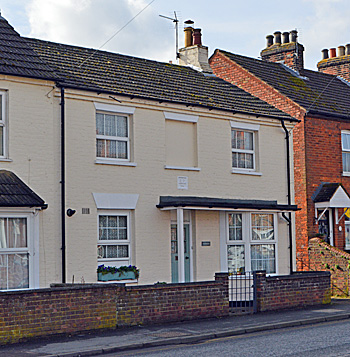The Vicar of Wakefield Public House Clapham

The former Vicar of Wakefield, March 2017
The Vicar of Wakefield Public House: 43 High Street, Clapham
In 1858 the cottage on the site of the later Vicar of Wakefield was conveyed to Alexander Hinton [ref: GK117/1]. In 1862 he conveyed it to Clapham baker, Daniel Farrer [ref: GK117/3]. Six years later Farrer leased the cottage to Baldock [Hertfordshire] brewer John Steed, with a covenant to pull the cottage down and rebuild it according to agreed plans [ref: GK117/4]. This, presumably, marks the beginning of the life of the beerhouse. This presumption is probably confirmed by the countywide licensing register of 1876 which gives 1868 as the year the Vicar of Wakefield was first licensed, though the register is not always accurate as regards dates. The Vicar of Wakefield was a writen in the 18th century by Oliver Goldsmith but was stil la popular novel in the Victorian era.
In 1879 the trustees of the will of Daniel Farrer conveyed the beerhouse to Oliver Steed, who had succeeded his father John as owner of Baldock Brewery on John’s death in 1877. Oliver died in 1888 and the firm was purchased by Charles Morley for Burton-on-Trent [Staffordshire] brewer William Pickering, the firm becoming known as Morley and Company. In 1895 Pickering conveyed the beerhouse to Bedford brewers Newland and Nash [ref: GK117/6].
On 3rd March 1921 in a letter from Newland and Nash to estate agents and valuers Peacocks, acting on behalf of the petty sessions’ licensing function [ref: PK7/4/6] trade was stated to have been 116 barrels and 20½ dozen pint bottles of beer in 1919 and 122½ barrels and 75 dozen pint bottles in 1920. In 1922 Newland and Nash was sold to Biggleswade brewers Wells and Winch.
The Rating and Valuation Act 1925 specified that every building and piece of land in the country was to be assessed to determine its rateable value. The valuer visiting the Vicar of Wakefield [ref: DV1/C276/36] found that Wells and Winch Limited charged their tenant a rent of £15 per annum (“Rent was £11 Faulkner says”). Downstairs was a tap room (“fair”), a parlour (“small”), a living room and a cellar. Four bedrooms lay upstairs. Electric light was laid on. Trade was 1½ barrels and two dozen bottles of beer per week. A small stable and an open hovel stood outside.
Reference to a tap room shows that there was no bar as such. This makes it one of a small number of North Bedfordshire licensed houses without a bar. Some of the history of the Vicar of Wakefield in the latter part of the 20th century is recounted on the website The Lost Pubs of North Bedfordshire
At some point, probably in the 1950s, the Vicar of Wakefield will have become a fully-licensed public house. The license was not renewed in 1978 [PSB9/2] turning from a public house into a private one.
List of Licensees: note that this is not a complete list ; entries in italics refer to licensees where either beginning or end, or both, dates are not known:
1869-1871: Edwin Pheasey;
1876-1885: Isaac Keech;
1891: Thomas William Keech;
1903-1913: Mark Lilley;
1913-1940: Ruth Naomi Lilley
List of sources at Bedfordshire Archives:
- GK117/1: Conveyance of cottage: 1858;
- GK117/3: Conveyance of cottage: 1862;
- GK117/4: Lease and covenant to pull down and rebuild: 1868;
- GK117/5: Mortgage: 1874;
- GK117/5: Mortgage: 1877;
- GK117/5: Assignment of mortgage: 1877
- GK117/5: Conveyance of Vicar of Wakefield: 1879;
- GK117/6: Conveyance: 1895;
- PSB9/1: Register of Alehouse Licences - Bedford Petty Sessional Division: 1903-1935;
- PK7/4/6: Valuation: 1920-1921;
- PL/PH3/43: Photograph: 1950s;
- PSB9/2: Register of Licensed Premises: c. 1955-1995.